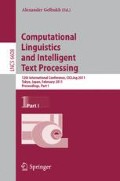Abstract
In this paper we introduce a new conjugating tool which generates and analyses both existing verbs and verb neologisms in Spanish. This application of finite state transducers is based on novel linguistically motivated morphological rules describing the verbal paradigm. Given that these transducers are simpler than the ones created in previous developments and are easy to learn and remember, the method can also be employed as a pedagogic tool in itself. A comparative evaluation of the tool against other online conjugators demonstrates its efficacy.
Access this chapter
Tax calculation will be finalised at checkout
Purchases are for personal use only
Preview
Unable to display preview. Download preview PDF.
References
Albright, A., Hayes, B.: Modeling English Past Tense Intuitions with Minimal Generalization. In: Proceedings of the 6th Workshop of the ACL Special Interest Group in Computational Phonology (SIGPHON), pp. 58–69 (2002)
Anick, P., Artemieff, S.: A high-level morphological description language exploiting inflectional paradigms. In: Proceedings of COLING 1992, pp. 67–73 (1992)
Basterrechea, E., Rello, L.: El verbo en español. Construye tu propio verbo. Molino de Ideas, Madrid (2010)
Beesley, K.R., Karttunen, L.: Finite-State Non-Concatenative Morphotactics. In: Proceedings of the 5th Workshop of the ACL Special Interest Group in Computational Phonology (SIGPHON), pp. 1–12 (2000)
Creutz, M., Lagus, K.: Induction of a Simple Morphology for Highly-Inflecting Languages. In: Proceedings of the 7th Meeting of the ACL Special Interest Group in Computational Phonology: Current Themes in Computational Phonology and Morphology, pp. 43–51 (2004)
Gasser, M.: Semitic Morphological Analysis and Generation Using Finite State Transducers with Feature Structures. In: Proceedings of the 12th Conference of the European Chapter of the ACL, pp. 309–317 (2009)
Gomis, P., Segura, L.: Vademécum del verbo español. In: SGEL. Sociedad General Española de Librería, Madrid (1998)
Görz, G.: A Finite State Approach to German Verb Morphology. In: Proceedings of COLING 1988, pp. 212–215 (1988)
Kaplan, R.M., Kay, M.: Regular models of phonological rule systems. Computational Linguistics 20, 331–378 (1994)
Karttunen, L.: KIMMO: A general morphological processor. Texas Linguistic Forum 22, 165–185 (1983)
Karttunen, L., Kaplan, R.M., Zaenen, A.: Two-level morphology with composition. In: Proceedings of COLING 1992, pp. 141–148 (1992)
Mateo, F.: Bescherelle. Les verbes espagnols. Hatier, Paris (2008)
Parkes, C.H., Malek, A.M., Marcus, M.P.: Towards Unsupervised Extraction of Verb Paradigms from Large Corpora. In: Proceedings of the 6th Workshop on Very Large Corpora, pp. 110–117 (2007)
Puebla, J.: Cómo conjugar todos los verbos del español. Playor, Madrid (1995)
Real Academia Española. Diccionario de la lengua española, 22th edn. Espasa, Madrid (2001)
Rello, L., Basterrechea, E.: Automatic conjugation and identification of regular and irregular verb neologisms in Spanish. In: Proceedings of the NAACL 2010, Workshop on Computational Approaches to Linguistic Creativity, CALC 2010 (2010)
Santana, O., Pérez, J.R., Hernández, Z.J., Carreras, F.J., Rodríguez, G.: FLAVER: Flexionador y lematizador automático de formas verbales. Lingüística Española Actual 19(2), 229–282 (1997)
Santana, O., Carreras, F.J., Hernández, Z.J., Pérez, J.R., Rodríguez, G.: Manual de la conjugación del español. 12 790 verbos conjugados. Arco Libros, Madrid (2002)
Tzoukermann, E., Liberman, M.Y.: A Finite-State Morphological Processor for Spanish. In: Proceedings of the 13th Conference on Computational Linguistics, vol. 1, pp. 277–282 (1990)
Author information
Authors and Affiliations
Editor information
Editors and Affiliations
Rights and permissions
Copyright information
© 2011 Springer-Verlag Berlin Heidelberg
About this paper
Cite this paper
Rello, L., Basterrechea, E. (2011). Onoma: A Linguistically Motivated Conjugation System for Spanish Verbs. In: Gelbukh, A.F. (eds) Computational Linguistics and Intelligent Text Processing. CICLing 2011. Lecture Notes in Computer Science, vol 6608. Springer, Berlin, Heidelberg. https://doi.org/10.1007/978-3-642-19400-9_18
Download citation
DOI: https://doi.org/10.1007/978-3-642-19400-9_18
Publisher Name: Springer, Berlin, Heidelberg
Print ISBN: 978-3-642-19399-6
Online ISBN: 978-3-642-19400-9
eBook Packages: Computer ScienceComputer Science (R0)

